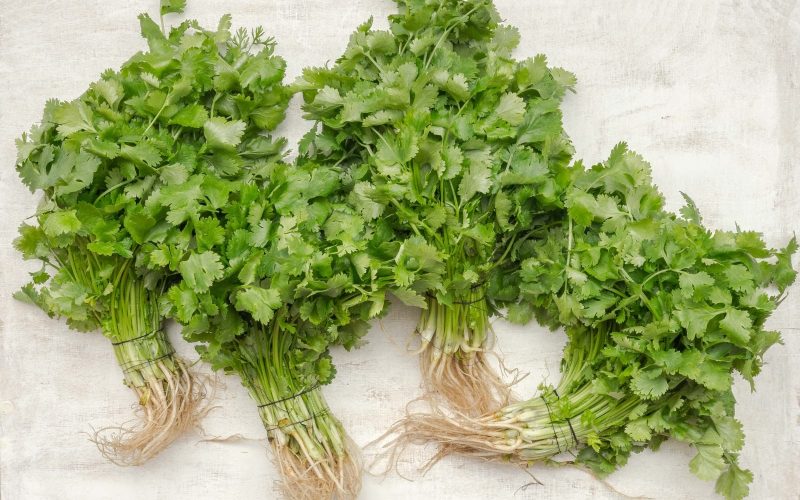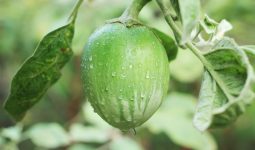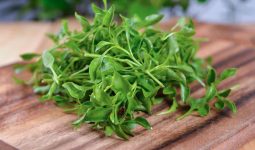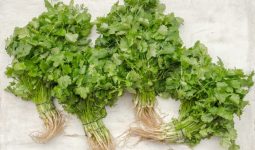Cilantro (Coriandrum sativum), the fresh coriander leaves, is native to southern Europe, northern Africa, and western Asia and was first cultivated in 2000 BC.
It was grown in the Hanging Gardens of Babylon and was one of the most popular spices, even in ancient Egypt and Greece.
The ancient Egyptians believed cilantro could be used as food in the afterlife, while the ancient Greeks ate it as food and used it as an ingredient in perfumes.
The leafy plant was brought to Mexico by Spanish conquistadors in the 16th century and soon after to the United States.
Sometimes called Chinese or Mexican parsley, different types of cilantro are now officially required ingredients in Tex-Mex recipes or Mexican fish dishes. They are also often used in Asian cuisine.
Cilantro is part of the Apiaceae family, which includes celery, cumin, carrots, and parsley. Annual cilantro has a bold citrus flavor and is used as an herb.
The dried seeds of the same plant, coriander, are used as a spice and have a distinctly different flavor.
Although it is produced in almost every country, this plant’s most important growing regions are the United States and Mexico.
The latter is the main world exporter; in the United States, California is the leading producer, followed by Arizona, Oregon, and Washington.
However, since cilantro grows worldwide, there are several different types, and where you live will determine which kind to cultivate.
All of the different types of cilantro are still Coriandrum sativum, with only slight variations in preferences and growing characteristics.
Additionally, all parts of cilantro are edible, but the leaves and seeds are often eaten. However, not everyone will like the taste of cilantro.
Fun fact: Cilantro is one of those herbs that people love or hate without compromise. Medical studies suggest the reason could be genetics. Some people can create an enzyme that reacts with compounds in cilantro and creates an unpleasant rancid or soapy taste.
Cilantro Or Coriander?
First, let’s clarify what cilantro is. There is often a lot of confusion about what cilantro is, what coriander is, and how they differ.
That’s fair enough because they’re the same plants and have many names.
Thus, the Coriandrum Sativum plant has very tasty leaves and seeds used in cuisines worldwide.
In English, cilantro refers to the plant’s leaves— the green plant you know.
The plant’s coriander seeds are often used as a spice or ground into powder.
The confusion arises because the whole plant is called coriander in many parts of the world, so the herb is also known as coriander.
The Spanish word for coriander is cilantro, which we borrow in English and call the leaves, but we still call the seeds coriander.
In India, they differentiate coriander leaves and roots by calling the coriander leaves the term “dhania.”
The seeds are very flavorful and can be used fresh — while still green — or more mature and dried.
I do not dispute that the whole plant is edible; the stems are also very tasty and perfect for sauces, and its flowers are palatable and beautiful!
Cultivation of Cilantro
Although different types of cilantro can be grown in different climates, temperatures between 50 and 80°F are ideal.
The plants can survive minor frost but not exposure to high temperatures.
Cilantro is grown year-round in California, with peak harvests from March through mid-November.
The Coachella Valley and Yuma in Arizona are harvested from November to March, and in Oregon and Washington from May to November.
Once germinated, seedlings need about an inch of water per week for optimal growth and leaf development.
Furrows or tape will prevent overwatering and disease. Plants are usually ready to harvest 40-45 days after sowing.
In general, cilantro can bolt quite easily. Bolting is when the plant decides to seed, sending up a strong stem that will flower and produce seeds.
At this point, the leaves begin to lose their flavor and sometimes become very bitter.
This indicates the end of the plant’s life cycle, so if cilantro begins to flower, you should harvest the leaves as soon as possible.
Cilantro usually begins to bolt in summer as temperatures rise and days get longer. I
f you live in a warm place where it gets hot much before summer; cilantro will bolt sooner.
Even if it is not too hot, your summer days are long, and it will also provoke cilantro to bolt.
Luckily, there are many types of bolt-resistant cilantro, as you’ll see as you read.
Cilantro has many varieties, including Leisure, Long-Standing, Terra, Calypso, Lemon, Caribe, Delfino, Slo Bolt, Jantar, Moroccan, Santos, and Costa Rica.
If you need plants that won’t flower when the humidity is too high, choose Santos and Slo-bolt; these are bolt-resistant species.
Let’s examine the different types of cilantro to determine which type is best for your climate and flavor profile.
Different Types of Cilantro
1. Leisure Cilantro
Let’s call leisure cilantro the standard flavor. You can eat whole leaves, stems, seeds, and even flowers.
Leisure is the most popular and common of the different types of cilantro. Most of the time, the cilantro you see at the grocery store will be leisure cilantro.
This type of cilantro was developed to be a popular variety, producing many leaves and bolts quite slowly.
It is bred to limit flowering in hot weather. As the name suggests, this species is the easiest to grow and requires some maintenance.
It has the shape of a feather, round tender leaves that are light green, and a flower stalk in the middle. It also has a spicy, aromatic, light, and sweet taste.
2. Indian Coriander (Dhania)
Despite its name, this plant still produces cilantro leaves. As with all the different cilantro plants, this one grows delicious leaves that can be sweet and slightly citrus.
Eventually, the plant will flower and produce seeds that can be harvested, like cilantro.
Native to the Indian subcontinent, this variety bolts quite quickly. This means the leaves are unavailable for as long, and the seeds are produced quickly.
Because this plant works like this, the seeds play a much more important role in Indian cuisine than the fresh leaves. They are mound-shaped and rounded.
It will be perfect to buy seeds produced in India; they are very different from the other cilantro groups in temperate climates.
You’ll soon love sauce with cilantro dipped in Tikki or Indian Snacks. And here’s a cheeky Indian recipe for you: Roasted Indian coriander with carrots, then puree and add to carrot soup, and for a sweet flavor, add a little orange juice.
3. Calypso Cilantro
Calypso cilantro tastes similar to Leisure cilantro but is highly valued for its growing properties.
These plants are particularly heat resistant, so they take time to flower.
And this is why they create large leafy bushes. In addition, the leaves also regrow very quickly after harvesting.
The cilantro gardens turn green during the cooler months in Southern California.
This vigorous variety produces plenty of leaves perfect for sauces and dressings and measures 12 to 18 inches tall and wide, larger than other types of cilantro. It has a slight lemon flavor and is slightly bitter.
4. Lemon Cilantro
Guess what this cilantro tastes like! This variety of cilantro is known for having a particularly strong citrus flavor that is often less noticeable in other types of cilantro, similar to lemon thyme.
The seeds are also incredibly tasty and contain all that compact lemon flavor. This type of cilantro requires a cooler climate and can withstand cold winters.
Due to its preference for cooler conditions, it will not grow well in southern regions with short winters and intense sun. It is a perfect replacement if you don’t have room for a lemon tree!
5. Caribe Cilantro
They have dark green leaves with slightly thin stems. Caribe is short for the Caribbean, and, as you can probably guess, it refers to a variety of cilantro that has adapted to grow in the Caribbean region.
Cilantro was first introduced to North America by Europeans who came to these regions and brought their foreign herbs and spices with them.
At first, the Caribbean region was too hot, but the cilantro plants adapted, and now we have caribe cilantro, which is perfect for warmer climates.
They are an upgraded version of leisure cilantro. It can keep cilantro in the garden long, withstand the summer heat, and resist bolting.
If you live in the southern United States and plan to plant cilantro outdoors, you will want to look for caribe coriander seeds.
They have a distinct flavor and are quite sweet. You will be happy to have cilantro as a secret ingredient for beans, salads, and soups.
You can also use it to make sauces for fried foods or as a spread on sandwiches on vegetarian days.
6. Marino Cilantro
This type of cilantro is different only in its taste. Marino leaves have a slightly spicier flavor, with a hint of pepper, instead of the fresh, citrus flavor of most cilantro leaves.
Like the average leisure cilantro variety, this variety also grows quite well and is slow to bolt.
It does not have characteristic features with leaves, and there is no particular need for cultivation.
7. Santo Cilantro
This cilantro has many names but refers to the same variety of cilantro. You may hear Low Standing Cilantro, California Santo, California Long Standing, or a combination.
Of the different types of cilantro, Santo is one of the strongest varieties because it has been bred to be bolt-resistant.
This means it takes longer to flower, so the leaves stay ready for harvest longer.
California grows the most cilantro in the United States, which is why you hear California cilantro.
Although no specific type of cilantro grows in California, as Santo is best suited to this climate, it is the most commonly grown cilantro there.
Its leaves are as broad as celery leaves. They have a strong smell that quickly disappears when cooked.
It is said that growing Santo for its leaves but harnessing its seeds and flowers also provides many significant benefits.
Do not worry. Try using flowers for decoration or mixing them in with your healthy meal prep ideas for salads.
8. Jantar Cilantro
This strain is also highly resistant to bolting, making it an excellent choice for any herb garden.
Santo and Jantar are the two slowest to bolt compared to the other types of cilantro.
These two are often used to grow and sell in shops or markets as their leaves will stay fresh and flavorful for longer.
If you’re a big cilantro fan, these varieties might be a better choice so you have a longer supply of fresh cilantro.
Also, if you reside further north, where the summer days are longer, you may want these slower varieties so they can handle the increased sunlight.
9. Delfino Cilantro
Cilantro Delfino is the only type of cilantro that looks very different from all the others.
It looks more like dill or carrot leaves than parsley-like, like most cilantro. This means the leaves are more fern-like with thinner tips.
Delfino Cilantro also has a much milder flavor than regular cilantro, which makes it more palatable to people who don’t like cilantro’s strong flavor.
Cool fall and winter weather is perfect for growing Delfino Cilantro, a staple for summer salsa dishes.
Because it yields so much more than other varieties, cilantro is used to make homemade salsa instead of store-bought salsa.
It also goes well with menus that call for chopped cilantro. This recipe can enhance your ideas for cooking soups, vegetables, sauces, and fish!
As with other types of cilantro, the leaves and seeds are edible. For Delfino, the seeds are also a little less strong.
10. Moroccan Cilantro
Moroccan cilantro has a slightly different flavor profile; it is outstandingly hot, spicy, and less acidic than other types.
However, in general, the growing process and gardening needs are the same as those of the other types of cilantro.
This variety has less flavorful leaves, which are said to have a milder cilantro flavor and a little more citrus flavor.
However, where the leaves lack flavor, the seeds make up for it. The seeds have a much stronger flavor than any other type of cilantro.
They add a slightly sweet citrus flavor to soups, cakes, curries, and chutneys.
They have short stems and small leaves (0.04-0.12 inches) and are usually dark green.
This type of cilantro is quick to bolt and will bolt when provoked by the hot weather.
Since this strain produces seeds faster and with much more flavor, this would be a great strain if you like and prefer coriander seeds over fresh cilantro leaves. They are sweeter than Indian coriander.
11. Culantro
Yes, culantro not cilantro. This plant is Eryngium Foetidum, not the same plant as Coriandrum Sativum. It also looks very different.
This type of cilantro is a saw-shaped leaved plant because the edges of cilantro leaves are often toothed or serrated, lanceolate, and long like a rosette.
The long leaves of this plant look more like dandelion leaves than cilantro leaves.
This plant is a variant of cilantro that grows in Mexico and Central America.
Other names for culantro are fitweed, saw-leaved herb, spiritweed, black benny, or spiny coriander.
While the people of Puerto Rico call this popular plant Recao, some parts of the Caribe call it Chandon Beni or Mexican coriander.
Culantro has a sweet citrus and floral aroma and is an ideal combination with black pepper, cumin, and thyme. These plants are much more heat resistant than cilantro, so they grow in these regions.
Culantro tastes the same as cilantro leaves but much stronger. Adding these leaves while cooking is recommended so the flavor is evenly distributed and slightly mellow.
It is also an excellent element of Costa Rican cooking. Culantro is a different plant from coriander, and It does not produce seeds like coriander.
12. Vietnamese Cilantro (Phak Phai)
This herb is technically not the same as cilantro but has equally flavorful leaves.
Vietnamese cilantro is Persicaria Odorata, more like a vine than an herb. This plant is native to Southeast Asia and prefers a tropical and humid climate.
This herb has darker leaves with smoother edges. It is pointed and oblong in shape, with a purple stripe down the middle.
It doesn’t look much like cilantro, but it can mimic the flavor very well.
Some swear by Vietnamese cilantro and say it’s better than the real thing. Note that the leaves will be damaged if frozen and should not be eaten.
Store the stem in water, cover the leaves with a plastic bag, and store them in the refrigerator for about a week.
In Southeast Asian countries, this plant aids digestion and is anti-inflammatory.
The fibers in Rau Ram help purify the body and warm the digestive system. The leaves are effective in treating colds and flu.
Fortunately, this plant bolts quite slowly. So, if you prefer the taste of its leaves, you will have plenty of leaves to harvest!
Choosing The Right Type
Now that you’ve seen all the different types of cilantro, you’re most likely a cilantro expert, right? Well, it’s okay if you’re still not entirely sure.
Each type is slightly different, so there isn’t a clear distinction between what will work for you and what won’t.
It’s because there’s no clear line where cilantro should be. It is partly for this reason that it is growing worldwide! It really can be planted anywhere.
The main thing you need to consider is the weather. Cilantro is considered a cool climate plant despite its association with Mexican and South Asian cuisine.
It’s not that cilantro wilts from the heat, but it will bolt sooner, and you won’t have as many fresh cilantro leaves. So, if you still prefer coriander seeds, no problem!
Think about your climate. If you live somewhere warmer, you might want to get a more bolt-resistant variety to increase the number of fresh leaves you will have.
Also, if you are already growing cilantro, try one of the varieties with a slightly different flavor, such as Moroccan or lemon cilantro, to add variety to your garden! In fact, why not try all the different types of cilantro?
Cilantro really isn’t a picky plant, and once it starts to grow, it will give you a nice fresh cilantro bush. So why not try different strains and see which suits you best?








